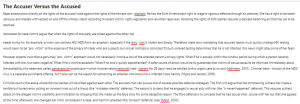The Accuser Versus the Accused

Rape prosecutions directly pit the rights of the accused male against the rights of the female com- plainant. He has the Sixth Amendment right to wage a vigorous defense through his attorney. She has a right to be taken seriously and treated with respect on and off the witness stand, according to recent victims’ rights legislation and rewritten rape laws. Honoring the rights of both parties requires a delicate balancing act that has yet to be resolved.
Advocates for rape victims argue that when the rights of one party are pitted against the other, her
needs trump his. For example, a victim can contract HIV/AIDS from an assailant, especially if the intru- sion is violent and bloody. Therefore, state laws mandating that accused rapists must quickly undergo HIV testing would seem to be “pro- victim” at the expense of the privacy of males who are suspects but not yet indicted or convicted. If court-ordered testing determines that he is not infected, this news might allay some of her fears.
However, experts insist that a genuinely “pro- victim” approach would not necessarily involve a loss of the arrested person’s privacy rights. What if he is actually within the window period during which a person recently infected with the virus tests negative? What if he is not the assailant? What if no one is quickly apprehended? A safer course of action would be to guarantee that victims of sexual assaults be informed immediately about the availability of a treatment called postexposure prophylaxis—which involves taking retroviral med- ications for 28 days—and be entitled to this urgent care at no cost (Hofmann, 2007). Criminal trans- mission of the AIDS virus is a separate punishable offense, but it also can be the reason for sentencing an attacker who knows he is infected more harshly (Myers and Jacobo, 2006).
Criminal court is the arena where the two parties will be pitted against each other. The accused man can pursue one of several possible defense strategies. The first is to argue that the complaining witness has made a terrible but honest error, picking an innocent man out of a lineup (the “mistaken identity” defense). The second is to deny that he engaged in sexual acts with her (the “it-never-happened” defense). This requires a direct attack on the alleged victim’s credibility and motivation by charging that she made up the false story for some deceptive reason. The third defense is to concede that he had sexual inter- course with her but that she agreed at the time; afterward, she changed her mind, considered it a rape, and had him arrested (the “consent” defense) (see Toobin, 2003).
Built-in antivictim biases that shaped the way cases were investigated and prosecuted were most evident in the corroboration rule, the resistance
V I C T IMS OF R AP E S AN D OT H E R S E XUAL AS S AULT S 349
Copyright 2016 Cengage Learning. All Rights Reserved. May not be copied, scanned, or duplicated, in whole or in part. WCN 02-200-203
requirement, and the practice of inquiring into the complainant’s sexual history in order to discredit her testimony. However, as public alarm grew about an apparent upsurge in sexual violence, leg- islators became more willing to change sexist prac- tices that reflected the moralistic assumptions of the distant past. Beginning with Minnesota and Michigan in 1974, statutes were rewritten state by state as the analysis put forward by feminists gained acceptance and as more women became lawyers and legislators and reformed the legal system from within as well as pressuring it from without (Largen, 1987).
The issue of consent is central to any rape com- plaint because willingness or at least voluntary com- pliance is what distinguishes engaging in sexual relations from being sexually assaulted. The injured party must convince the police, the prosecution, and ultimately a jury that she did not agree freely to participate in sex acts but was forced to submit by her attacker. The burden of proof shifts to the woman, who must present a compelling account that she was violated against her will. The prosecu- tion must establish beyond a reasonable doubt that she was forced—hit, knocked down, pinned down, overpowered, or threatened with serious bodily harm. The prosecution must also show that she is a woman of integrity and good character, who has no motive to distort the truth and ought to be believed. To stir up reasonable doubts, the defense will pursue a strategy of impeaching her credibility by attacking her virtue. The goal is to sow the seeds of doubt among jurors by asserting that she consented at the time but later regretted her decision and then lodged false charges. To undermine her credibility as the key prosecution witness, the defense attorney often pur- sues a “nuts and sluts” strategy, portraying her as a mentally unstable liar and/or a sexually promiscuous, willing partner to many others.
To counter such personal attacks, the prosecu- tion must argue that the defense attorney is turning the tables and is putting the victim on trial and humiliating her once again, this time in front of the jury. From the complainant’s point of view, some reasonable limits should be placed on the defense’s cross-examination so it doesn’t become a
degrading spectacle. But from the defendant’s point of view, it is only fair that she answer probing ques- tions about her sexual involvements in the past and her mental health. Only then can he have a fighting chance to clear his name and expose the falseness of her charges against him in this credibility contest (see Estrich, 1993b; and Vachss, 1993).